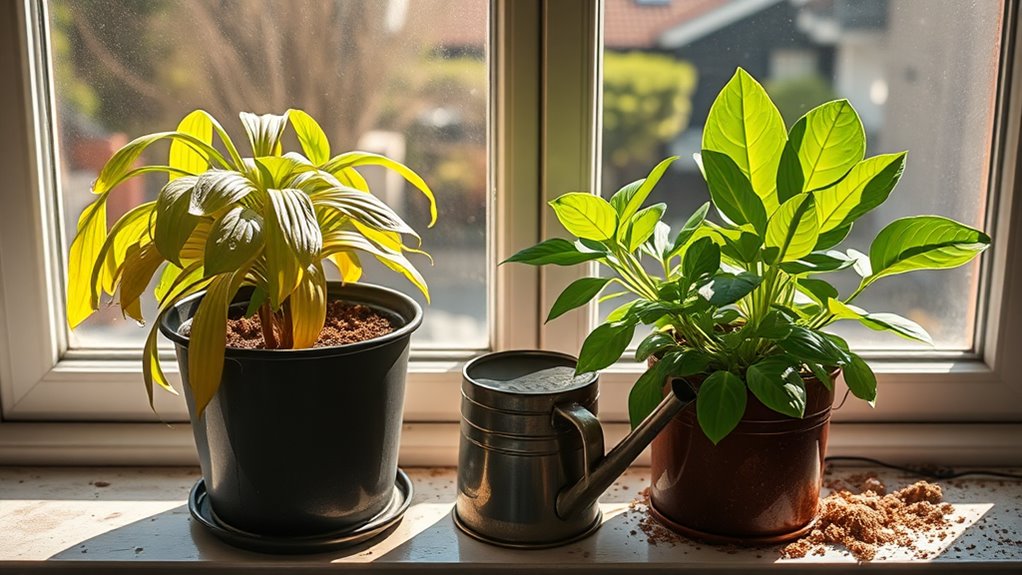Are You Watering Too Much or Too Little. Here’s the Fix
When it comes to plant care, finding the right watering balance is vital for their health. Overwatered plants often show signs like yellowing leaves, while those needing more water may have crispy tips and wilting foliage. To ensure your plants thrive, you need to assess your watering habits and adjust them accordingly. So, how do you identify if you’re giving too much or not enough? The solution lies in understanding your plants’ specific needs and the conditions they’re growing in.
Understanding Plant Watering Needs
When determining how to effectively water your plants, it’s crucial to understand their specific needs.
A comprehensive plant watering guide helps you assess factors like species, soil type, and environmental conditions. Different plants have varying water requirements, so it’s essential to tailor your approach.
Regularly check soil moisture levels and adjust your watering schedule accordingly to promote healthy growth and avoid stress on your plants. Additionally, understanding root zone moisture is vital for delivering optimal hydration to your plants.
Signs of Overwatering
One key symptom of overwatering is the presence of yellowing leaves, which often indicates that the roots are suffocating in overly saturated soil.
Other signs to look for include:
- Wilting, despite wet soil
- Root rot leading to a foul smell
- Mold or algae on the soil surface
- Soil that remains constant wetness
- Leaf drop or leaf spots
Stay vigilant to prevent damage! Understanding optimal watering schedules can help you maintain the right balance for plant health.
Signs of Underwatering
If you’re noticing changes in your plants, underwatering could be the culprit. Signs include crispy, brown leaf tips, wilting stems, and dry soil that cracks.
Leaves may also become discolored, turning yellow or dropping off. Frequent drooping, particularly during the day, indicates stress from inadequate moisture.
Regularly assessing soil moisture helps you identify these symptoms early and address issues promptly. Additionally, understanding soil preparation techniques can contribute significantly to preventing underwatering issues.
How to Adjust Your Watering Routine
Adjusting your watering routine is essential for maintaining healthy plants, especially after identifying signs of underwatering or overwatering.
To create an effective watering schedule, consider the following:
- Check soil moisture regularly.
- Adjust frequency based on weather conditions.
- Use drainage systems to prevent waterlogging.
- Group plants with similar needs together.
- Observe plant responses to fine-tune your approach.
Additionally, you can implement efficient watering methods like drip irrigation to save time and resources while ensuring your plants receive adequate moisture.
Best Practices for Watering Plants
Developing a solid watering routine naturally leads to implementing best practices for watering plants. Focus on timing, quantity, and method. Water early in the morning or late afternoon, applying enough to saturate the soil without runoff. Utilize drip irrigation or soaker hoses for efficiency. Additionally, busy gardeners can benefit from simple watering tips that fit their schedules.
| Aspect | Best Practice | Explanation |
|---|---|---|
| Timing | Early Morning or Late Afternoon | Reduces evaporation, maximizes absorption |
| Quantity | Deep, Infrequent Watering | Encourages deep root growth |
| Method | Drip Irrigation | Consistent moisture delivery |
Tools and Techniques for Monitoring Soil Moisture
Monitoring soil moisture accurately is essential for preventing overwatering and underwatering, as it allows you to respond proactively to your plants’ needs.
To effectively track moisture levels, consider using these tools and techniques:
- Soil moisture sensors
- Tensiometers
- Simple soil probes
- Weighing pots
- Soil moisture charts
Employing these methods will help you maintain optimal hydration for healthier plants. Additionally, understanding essential soil preparation can greatly influence how moisture retention occurs in your garden.

